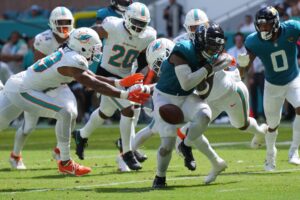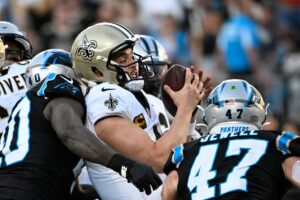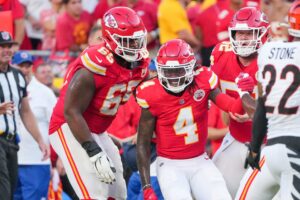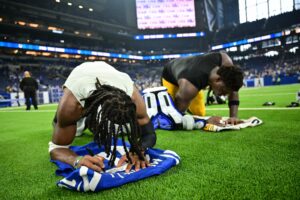The deadline for all teams to cut their rosters down to 53 has passed, and thus the Chargers have set their final 53-man roster. It came with a few surprises – but mostly more on who did end up making the roster in the end rather than who didn’t. Let’s take a look at the final roster and final cuts.
Looking at the 2024 Los Angeles Chargers Roster Cuts
Most Notable Cuts
Most of the cuts did not come as that much of a surprise. For example, running back Isaiah Spiller was waived after just two years. He’d averaged 2.5 yards per carry in that time and had a quite poor preseason. Elijah Dotson did not make the roster either, meaning that this year there is a completely new slate of running backs with no returning members from last year (unless you count Jaret Patterson, but he spent all of last year on the practice squad).
The most surprising cut was tight end Donald Parham. Granted, Jim Harbaugh does seem to favor tight ends who can block, and that has never been Parham’s strong suit. But his physical ability and status as a red-zone threat seemed to make it likely he would stick around, given the lack of a clear competitor at TE3. But he was released in the end, while Stone Smartt made it instead.
Elsewhere, former first-round offensive tackle Alex Leatherwood – originally drafted by the Raiders, and one of the biggest busts in recent memory – was cut. So was Luis Perez, who’d been fighting for a backup quarterback spot. Also, seventh-round rookie wide receiver Cornelius Johnson was cut – the only draft pick this year to get cut. This is not much of a surprise, as there simply wasn’t room for him.
Most Notable Keeps
The most notable breakout player of the preseason was wide receiver Simi Fehoko. He only had one catch last year (though it was a touchdown) and spent most of his time either on special teams – or on the practice squad. However, he had a great preseason and cemented himself as a potential new big-play-maker. And despite competition at the receiver position, he managed to land a roster spot. He will probably retain his role on special teams, but we will see what he can do as a pass-catcher as well in the regular season.
A close second was safety Tony Jefferson – although he wasn’t really a breakout player, given that he was a veteran who’d been a starter before; he’d just been mostly out of the league for a while. His playing well enough to grab a spot after the time off was notable. He had one of the better performances of the preseason in general in Week 3.
On that note, JT Woods sticking around as well was a surprise. He’d struggled his first two years in the league, and it would have been fair to assume that he would’ve been a casualty of the regime switch alongside Spiller. However, he improved this off-season – not only enough to survive the Chargers roster cuts, but enough that the Chargers kept five safeties, which is unusual.
Other Notable Decisions
Semi Fehoko making the roster was notable in of itself, but what was also notable was that the Chargers kept seven wide receivers on the roster – more than the standard five or six. Even with five spots locked in and Fehoko breaking out, seventh-round rookie Brenden Rice made the roster as well – which shows the level of investment the Chargers have in him, as compared to fellow seventh-round rookie Cornelius Johnson, who did not make it.
Elsewhere, the battle for backup quarterback gained some attention outside of Chargers fans – due to the quite poor play of Easton Stick. The Chargers brought in Luis Perez from the UFL for extra competition, and he gave it a good shot – but in the end, Perez and second-year quarterback Max Duggan were both cut, leaving the Chargers to stick with the status quo in Stick. It’s possible they may scoop up a new backup quarterback in the coming days off the waiver wire, but in the meantime, Chargers fans will simply have to hope Herbert does not get hurt.
Main Photo:






